Hongke Zhao
Diffmv: A Unified Diffusion Framework for Healthcare Predictions with Random Missing Views and View Laziness
May 17, 2025Abstract:Advanced healthcare predictions offer significant improvements in patient outcomes by leveraging predictive analytics. Existing works primarily utilize various views of Electronic Health Record (EHR) data, such as diagnoses, lab tests, or clinical notes, for model training. These methods typically assume the availability of complete EHR views and that the designed model could fully leverage the potential of each view. However, in practice, random missing views and view laziness present two significant challenges that hinder further improvements in multi-view utilization. To address these challenges, we introduce Diffmv, an innovative diffusion-based generative framework designed to advance the exploitation of multiple views of EHR data. Specifically, to address random missing views, we integrate various views of EHR data into a unified diffusion-denoising framework, enriched with diverse contextual conditions to facilitate progressive alignment and view transformation. To mitigate view laziness, we propose a novel reweighting strategy that assesses the relative advantages of each view, promoting a balanced utilization of various data views within the model. Our proposed strategy achieves superior performance across multiple health prediction tasks derived from three popular datasets, including multi-view and multi-modality scenarios.
Attention Mechanisms Perspective: Exploring LLM Processing of Graph-Structured Data
May 04, 2025Abstract:Attention mechanisms are critical to the success of large language models (LLMs), driving significant advancements in multiple fields. However, for graph-structured data, which requires emphasis on topological connections, they fall short compared to message-passing mechanisms on fixed links, such as those employed by Graph Neural Networks (GNNs). This raises a question: ``Does attention fail for graphs in natural language settings?'' Motivated by these observations, we embarked on an empirical study from the perspective of attention mechanisms to explore how LLMs process graph-structured data. The goal is to gain deeper insights into the attention behavior of LLMs over graph structures. We uncovered unique phenomena regarding how LLMs apply attention to graph-structured data and analyzed these findings to improve the modeling of such data by LLMs. The primary findings of our research are: 1) While LLMs can recognize graph data and capture text-node interactions, they struggle to model inter-node relationships within graph structures due to inherent architectural constraints. 2) The attention distribution of LLMs across graph nodes does not align with ideal structural patterns, indicating a failure to adapt to graph topology nuances. 3) Neither fully connected attention nor fixed connectivity is optimal; each has specific limitations in its application scenarios. Instead, intermediate-state attention windows improve LLM training performance and seamlessly transition to fully connected windows during inference. Source code: \href{https://github.com/millioniron/LLM_exploration}{LLM4Exploration}
Collaborative Knowledge Fusion: A Novel Approach for Multi-task Recommender Systems via LLMs
Oct 28, 2024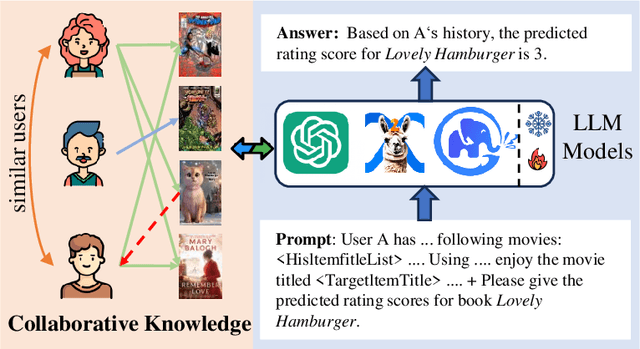
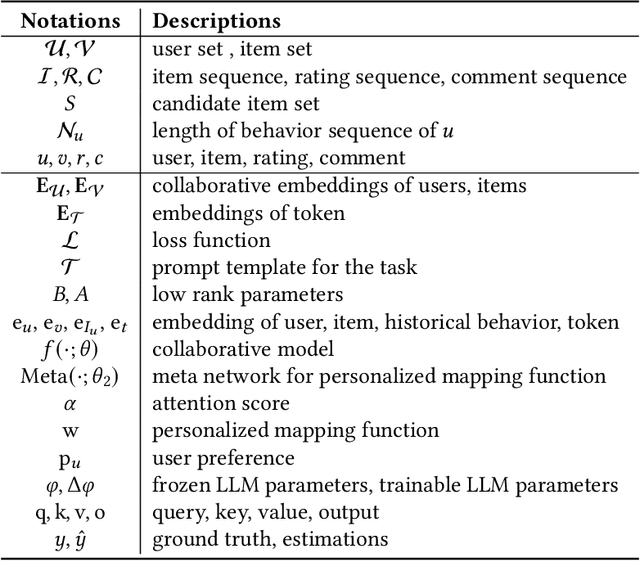


Abstract:Owing to the impressive general intelligence of large language models (LLMs), there has been a growing trend to integrate them into recommender systems to gain a more profound insight into human interests and intentions. Existing LLMs-based recommender systems primarily leverage item attributes and user interaction histories in textual format, improving the single task like rating prediction or explainable recommendation. Nevertheless, these approaches overlook the crucial contribution of traditional collaborative signals in discerning users' profound intentions and disregard the interrelatedness among tasks. To address these limitations, we introduce a novel framework known as CKF, specifically developed to boost multi-task recommendations via personalized collaborative knowledge fusion into LLMs. Specifically, our method synergizes traditional collaborative filtering models to produce collaborative embeddings, subsequently employing the meta-network to construct personalized mapping bridges tailored for each user. Upon mapped, the embeddings are incorporated into meticulously designed prompt templates and then fed into an advanced LLM to represent user interests. To investigate the intrinsic relationship among diverse recommendation tasks, we develop Multi-Lora, a new parameter-efficient approach for multi-task optimization, adept at distinctly segregating task-shared and task-specific information. This method forges a connection between LLMs and recommendation scenarios, while simultaneously enriching the supervisory signal through mutual knowledge transfer among various tasks. Extensive experiments and in-depth robustness analyses across four common recommendation tasks on four large public data sets substantiate the effectiveness and superiority of our framework.
GANPrompt: Enhancing Robustness in LLM-Based Recommendations with GAN-Enhanced Diversity Prompts
Aug 19, 2024



Abstract:In recent years, LLM has demonstrated remarkable proficiency in comprehending and generating natural language, with a growing prevalence in the domain of recommender systems. However, LLM continues to face a significant challenge in that it is highly susceptible to the influence of prompt words. This inconsistency in response to minor alterations in prompt input may compromise the accuracy and resilience of recommendation models. To address this issue, this paper proposes GANPrompt, a multi-dimensional large language model prompt diversity framework based on Generative Adversarial Networks (GANs). The framework enhances the model's adaptability and stability to diverse prompts by integrating GAN generation techniques with the deep semantic understanding capabilities of LLMs. GANPrompt first trains a generator capable of producing diverse prompts by analysing multidimensional user behavioural data. These diverse prompts are then used to train the LLM to improve its performance in the face of unseen prompts. Furthermore, to ensure a high degree of diversity and relevance of the prompts, this study introduces a mathematical theory-based diversity constraint mechanism that optimises the generated prompts to ensure that they are not only superficially distinct, but also semantically cover a wide range of user intentions. Through extensive experiments on multiple datasets, we demonstrate the effectiveness of the proposed framework, especially in improving the adaptability and robustness of recommender systems in complex and dynamic environments. The experimental results demonstrate that GANPrompt yields substantial enhancements in accuracy and robustness relative to existing state-of-the-art methodologies.
LANE: Logic Alignment of Non-tuning Large Language Models and Online Recommendation Systems for Explainable Reason Generation
Jul 03, 2024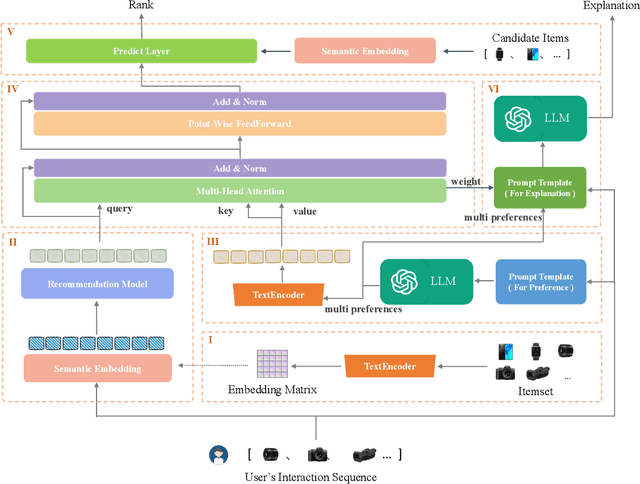
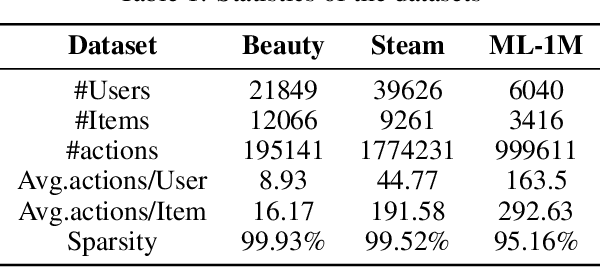
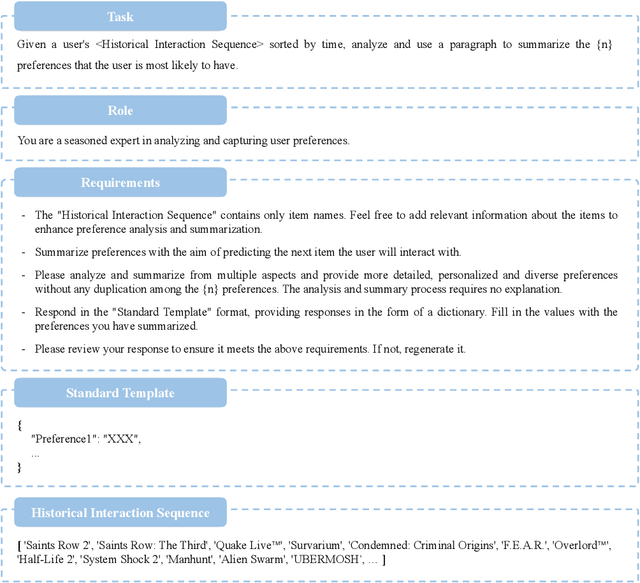
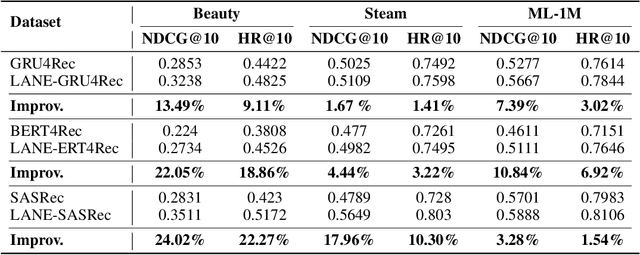
Abstract:The explainability of recommendation systems is crucial for enhancing user trust and satisfaction. Leveraging large language models (LLMs) offers new opportunities for comprehensive recommendation logic generation. However, in existing related studies, fine-tuning LLM models for recommendation tasks incurs high computational costs and alignment issues with existing systems, limiting the application potential of proven proprietary/closed-source LLM models, such as GPT-4. In this work, our proposed effective strategy LANE aligns LLMs with online recommendation systems without additional LLMs tuning, reducing costs and improving explainability. This innovative approach addresses key challenges in integrating language models with recommendation systems while fully utilizing the capabilities of powerful proprietary models. Specifically, our strategy operates through several key components: semantic embedding, user multi-preference extraction using zero-shot prompting, semantic alignment, and explainable recommendation generation using Chain of Thought (CoT) prompting. By embedding item titles instead of IDs and utilizing multi-head attention mechanisms, our approach aligns the semantic features of user preferences with those of candidate items, ensuring coherent and user-aligned recommendations. Sufficient experimental results including performance comparison, questionnaire voting, and visualization cases prove that our method can not only ensure recommendation performance, but also provide easy-to-understand and reasonable recommendation logic.
Performative Debias with Fair-exposure Optimization Driven by Strategic Agents in Recommender Systems
Jun 25, 2024Abstract:Data bias, e.g., popularity impairs the dynamics of two-sided markets within recommender systems. This overshadows the less visible but potentially intriguing long-tail items that could capture user interest. Despite the abundance of research surrounding this issue, it still poses challenges and remains a hot topic in academic circles. Along this line, in this paper, we developed a re-ranking approach in dynamic settings with fair-exposure optimization driven by strategic agents. Designed for the producer side, the execution of agents assumes content creators can modify item features based on strategic incentives to maximize their exposure. This iterative process entails an end-to-end optimization, employing differentiable ranking operators that simultaneously target accuracy and fairness. Joint objectives ensure the performance of recommendations while enhancing the visibility of tail items. We also leveraged the performativity nature of predictions to illustrate how strategic learning influences content creators to shift towards fairness efficiently, thereby incentivizing features of tail items. Through comprehensive experiments on both public and industrial datasets, we have substantiated the effectiveness and dominance of the proposed method especially on unveiling the potential of tail items.
Cross-domain Transfer of Valence Preferences via a Meta-optimization Approach
Jun 24, 2024



Abstract:Cross-domain recommendation offers a potential avenue for alleviating data sparsity and cold-start problems. Embedding and mapping, as a classic cross-domain research genre, aims to identify a common mapping function to perform representation transformation between two domains. Nevertheless, previous coarse-grained preference representations, non-personalized mapping functions, and excessive reliance on overlapping users limit their performance, especially in scenarios where overlapping users are sparse. To address aforementioned challenges, we propose a novel cross-domain approach, namely CVPM. CVPM formalizes cross-domain interest transfer as a hybrid architecture of parametric meta-learning and self-supervised learning, which not only transfers user preferences at a finer level, but also enables signal enhancement with the knowledge of non-overlapping users. Specifically, with deep insights into user preferences and valence preference theory, we believe that there exists significant difference between users' positive preferences and negative behaviors, and thus employ differentiated encoders to learn their distributions. In particular, we further utilize the pre-trained model and item popularity to sample pseudo-interaction items to ensure the integrity of both distributions. To guarantee the personalization of preference transfer, we treat each user's mapping as two parts, the common transformation and the personalized bias, where the network used to generate the personalized bias is output by a meta-learner. Furthermore, in addition to the supervised loss for overlapping users, we design contrastive tasks for non-overlapping users from both group and individual-levels to avoid model skew and enhance the semantics of representations. Exhaustive data analysis and extensive experimental results demonstrate the effectiveness and advancement of our proposed framework.
LangTopo: Aligning Language Descriptions of Graphs with Tokenized Topological Modeling
Jun 19, 2024Abstract:Recently, large language models (LLMs) have been widely researched in the field of graph machine learning due to their outstanding abilities in language comprehension and learning. However, the significant gap between natural language tasks and topological structure modeling poses a nonnegligible challenge. Specifically, since natural language descriptions are not sufficient for LLMs to understand and process graph-structured data, fine-tuned LLMs perform even worse than some traditional GNN models on graph tasks, lacking inherent modeling capabilities for graph structures. Existing research overly emphasizes LLMs' understanding of semantic information captured by external models, while inadequately exploring graph topological structure modeling, thereby overlooking the genuine capabilities that LLMs lack. Consequently, in this paper, we introduce a new framework, LangTopo, which aligns graph structure modeling with natural language understanding at the token level. LangTopo quantifies the graph structure modeling capabilities of GNNs and LLMs by constructing a codebook for the graph modality and performs consistency maximization. This process aligns the text description of LLM with the topological modeling of GNN, allowing LLM to learn the ability of GNN to capture graph structures, enabling LLM to handle graph-structured data independently. We demonstrate the effectiveness of our proposed method on multiple datasets.
Enhancing Collaborative Semantics of Language Model-Driven Recommendations via Graph-Aware Learning
Jun 19, 2024



Abstract:Large Language Models (LLMs) are increasingly prominent in the recommendation systems domain. Existing studies usually utilize in-context learning or supervised fine-tuning on task-specific data to align LLMs into recommendations. However, the substantial bias in semantic spaces between language processing tasks and recommendation tasks poses a nonnegligible challenge. Specifically, without the adequate capturing ability of collaborative information, existing modeling paradigms struggle to capture behavior patterns within community groups, leading to LLMs' ineffectiveness in discerning implicit interaction semantic in recommendation scenarios. To address this, we consider enhancing the learning capability of language model-driven recommendation models for structured data, specifically by utilizing interaction graphs rich in collaborative semantics. We propose a Graph-Aware Learning for Language Model-Driven Recommendations (GAL-Rec). GAL-Rec enhances the understanding of user-item collaborative semantics by imitating the intent of Graph Neural Networks (GNNs) to aggregate multi-hop information, thereby fully exploiting the substantial learning capacity of LLMs to independently address the complex graphs in the recommendation system. Sufficient experimental results on three real-world datasets demonstrate that GAL-Rec significantly enhances the comprehension of collaborative semantics, and improves recommendation performance.
Dr.E Bridges Graphs with Large Language Models through Words
Jun 19, 2024



Abstract:Significant efforts have been directed toward integrating powerful Large Language Models (LLMs) with diverse modalities, particularly focusing on the fusion of vision, language, and audio data. However, the graph-structured data, inherently rich in structural and domain-specific knowledge, have not yet been gracefully adapted to LLMs. Existing methods either describe the graph with raw text, suffering the loss of graph structural information, or feed Graph Neural Network (GNN) embeddings directly into LLM at the cost of losing semantic representation. To bridge this gap, we introduce an innovative, end-to-end modality-aligning framework, equipped with a pretrained Dual-Residual Vector Quantized-Variational AutoEncoder (Dr.E). This framework is specifically designed to facilitate token-level alignment with LLMs, enabling an effective translation of the intrinsic `language' of graphs into comprehensible natural language. Our experimental evaluations on standard GNN node classification tasks demonstrate competitive performance against other state-of-the-art approaches. Additionally, our framework ensures interpretability, efficiency, and robustness, with its effectiveness further validated under both fine-tuning and few-shot settings. This study marks the first successful endeavor to achieve token-level alignment between GNNs and LLMs.
 Add to Chrome
Add to Chrome Add to Firefox
Add to Firefox Add to Edge
Add to Edge